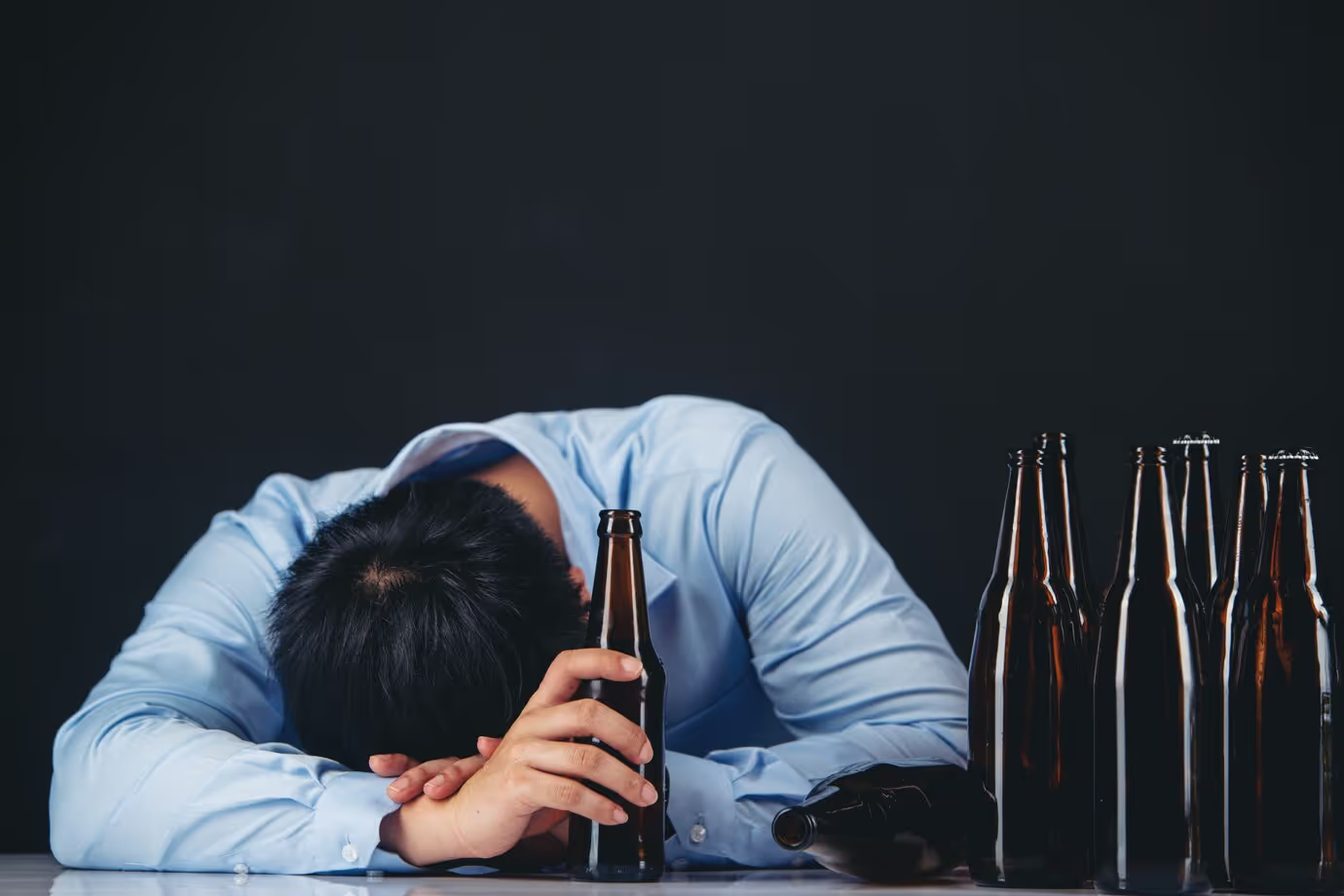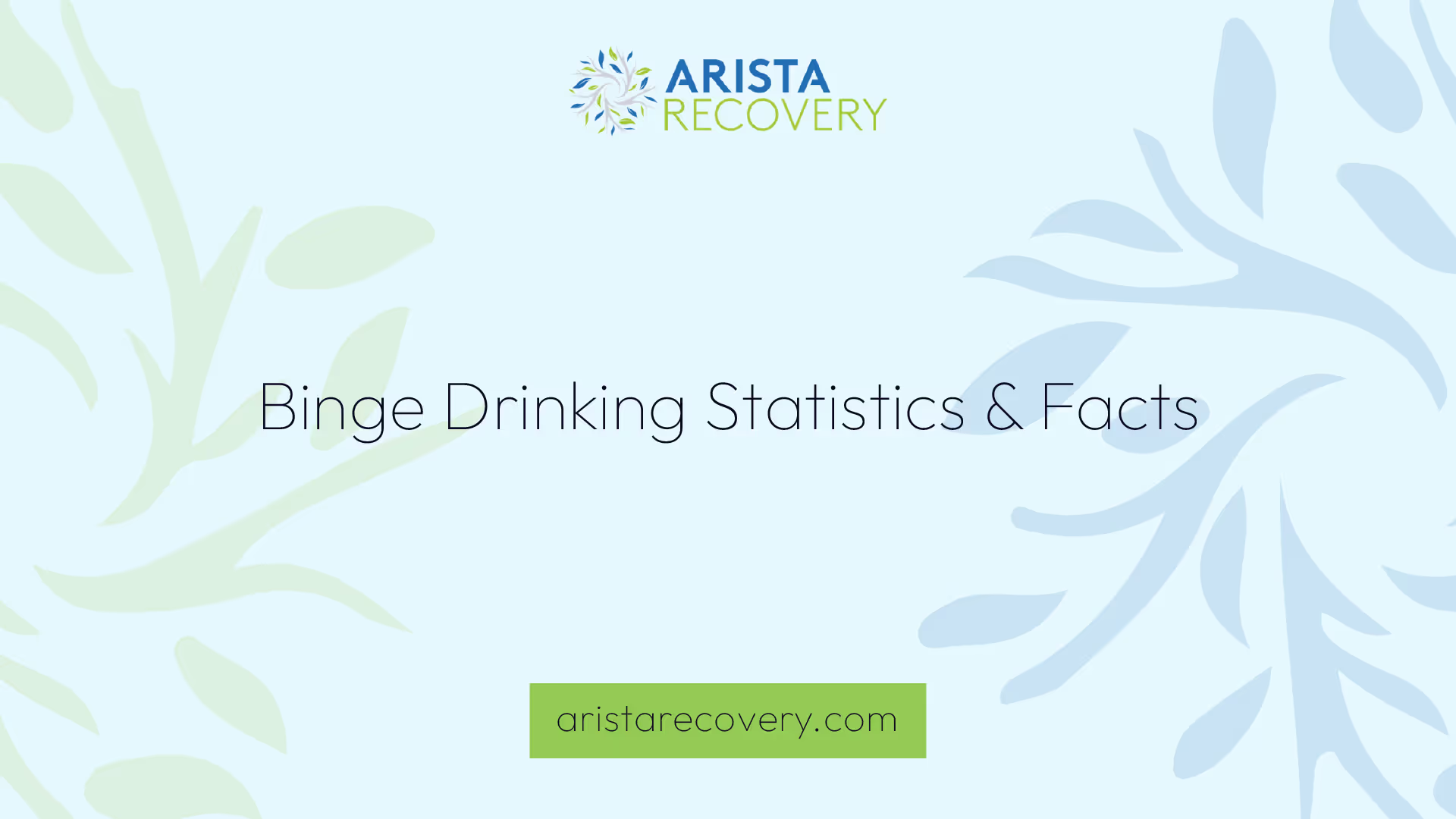Binge Drinking Statistics & Facts

Top 10 Key Binge Drinking Statistics & Facts
Here are the top 10 key statistics about binge drinking:

- Binge drinking is defined as a pattern of drinking that brings a person’s blood alcohol concentration (BAC) to 0.08 grams percent or above.
- Men who consume five or more drinks and women who consume four or more drinks in about 2 hours are considered binge drinkers.
- Approximately 1 in 6 adults in the United States binge drink about four times per month, consuming about seven drinks per binge.
- Binge drinking is most common among young adults aged 18-34, with 34.9% of people in this age group reporting binge drinking in the past month in 2019.
- Binge drinking is more common among men than women, with 24.6% of men and 14.6% of women reporting binge drinking in the past month in 2019.
- Binge drinking is associated with a variety of health problems, ranging from acute risks such as unintentional injuries and sexually transmitted infections to more chronic issues like liver disease, heart disease, stroke, and other chronic diseases.
- Binge drinking is the most common, costly, and deadly pattern of excessive alcohol use in the United States, according to the Centers for Disease Control and Prevention (CDC).
- The financial toll of excessive alcohol consumption in the United States was approximated to be $249 billion in 2010, with binge drinking accounting for the majority of this cost.
- Excessive alcohol use, including binge drinking, led to around 95,000 deaths and 2.8 million years of potential life lost in the United States each year during the period 2011-2015.
- Understanding the demographics of binge drinking can help inform targeted interventions and policies aimed at reducing the prevalence and adverse effects of this behavior.
Understanding Binge Drinking
Binge drinking is a prevalent yet often misunderstood issue. This section aims to shed light on the definition and prevalence of binge drinking, providing a foundation to understand the binge drinking statistics & facts.
Definition of Binge Drinking
Binge drinking is defined as a pattern of drinking that brings a person’s blood alcohol concentration (BAC) to 0.08 grams percent or above. This typically occurs when men consume five or more drinks or women consume four or more drinks in about 2 hours, as per the National Institute on Alcohol Abuse and Alcoholism.
Here's a simple breakdown:
It's important to note that these figures are averages and the effects of alcohol can vary greatly depending on several factors, including weight, age, and overall health.
Prevalence of Binge Drinking
Binge drinking is a common behavior in the United States, particularly among young adults aged 18 to 34. Approximately 1 in 6 adults in the United States binge drink about four times per month, consuming about seven drinks per binge. This results in about 467 binge drinks per binge drinker annually [1].
Binge drinking is more common among men than women. In 2019, 24.6% of men and 14.6% of women reported binge drinking in the past month.
The prevalence of binge drinking varies across age groups:
Understanding the prevalence of binge drinking is crucial in addressing the many health and social problems related to excessive alcohol consumption. It forms the basis for developing effective strategies to curb binge drinking and minimize its negative impact on individuals and society at large.
The Dangers of Binge Drinking
The repercussions of binge drinking extend far beyond the immediate impacts, with both serious health risks and widespread societal consequences. Understanding the dangers associated with this behavior is crucial when discussing binge drinking statistics & facts.
Health Risks Associated with Binge Drinking
Binge drinking is associated with a variety of health problems, ranging from acute risks such as unintentional injuries (e.g., car crashes), intentional injuries (e.g., firearm injuries), sexually transmitted infections, and unintended pregnancy to more chronic issues like liver disease, heart disease, stroke, and other chronic diseases.
Societal Impact of Binge Drinking
The societal impact of binge drinking is extensive. It is associated with higher rates of sexual assault, violence, and risky sexual behaviors [2]. It is the most common, costly, and deadly pattern of excessive alcohol use in the United States, according to the Centers for Disease Control and Prevention (CDC).
Alcohol use is linked to chronic illnesses, malignancies, intentional and unintentional injuries, disrupted interpersonal relationships, workplace issues, and both violent and nonviolent crimes. It is the third leading cause of preventable death in the US and the fifth leading risk factor for premature death and disability worldwide [4].
These societal impacts underline the importance of taking a comprehensive approach to address the problem of binge drinking, which includes legal measures, public health policies, and educational interventions. Understanding the health risks and societal impacts associated with binge drinking can help to inform these strategies and contribute to their effectiveness.
Binge Drinking Demographics
The prevalence of binge drinking varies across different demographic groups, including age, gender, and socioeconomic status. In this section, we'll delve into the binge drinking statistics & facts associated with these demographics.
Age and Binge Drinking
Binge drinking is most common among young adults aged 18-34. According to the NIAAA, 34.9% of people in this age group reported binge drinking in the past month in 2019. In contrast, adults aged 65 and older reported the lowest prevalence of binge drinking in the same year, with only 5% engaging in this behavior in the past month.
Gender and Binge Drinking
Binge drinking is more common among men than women. In 2019, 24.6% of men and 14.6% of women reported binge drinking in the past month [5]. Furthermore, binge drinking rates are higher among male college students compared to female college students. From 1988 to 2014, male binge drinking decreased from 52% to 43%, while female binge drinking decreased from 31% to 26%.
Socioeconomic Status and Binge Drinking
The relationship between socioeconomic status and binge drinking is complex and influenced by multiple factors. For instance, individuals with higher levels of education and income are more likely to consume alcohol but less likely to engage in heavy or hazardous drinking. Conversely, individuals with lower socioeconomic status may face higher levels of stress and lower access to resources for managing alcohol-related issues, increasing their risk of binge drinking. However, more specific data is needed to further evaluate this relationship.
Understanding the demographics of binge drinking can help inform targeted interventions and policies aimed at reducing the prevalence and adverse effects of this behavior. It's important to note that while these trends provide insight into patterns of binge drinking, alcohol misuse can affect anyone, regardless of age, gender, or socioeconomic status. Therefore, strategies to curb binge drinking should be comprehensive, incorporating a range of approaches to effectively address this public health issue.
Economic Cost of Binge Drinking
The economic implications of binge drinking are vast and multifaceted. From loss in workplace productivity, increased healthcare expenses, to criminal justice costs, the societal burden is significant.
Direct and Indirect Costs
The financial toll of excessive alcohol consumption in the United States was approximated to be $249 billion in 2010, with binge drinking accounting for the majority of this cost. To break it down further, binge drinking reportedly costs the United States about $191 billion annually.
The direct and indirect costs incurred due to binge drinking include:
- Loss in workplace productivity: Alcohol-induced impairment can impact the performance and productivity of individuals at work, leading to loss in income and overall economic output.
- Healthcare expenses: The adverse health effects of excessive alcohol consumption necessitate medical attention, leading to increased healthcare costs.
- Criminal justice expenses: Binge drinking is associated with increased crime rates, leading to higher criminal justice costs.
- Other costs: Costs incurred due to other consequences of binge drinking, such as motor vehicle accidents, and the resultant property damage and loss of life.
Figures courtesy CDC
Excessive alcohol use, including binge drinking, led to around 95,000 deaths and 2.8 million years of potential life lost in the United States each year during the period 2011-2015. This loss of life also translates to significant economic costs, including lost earnings of potential workers and increased healthcare expenses.
The economic cost of binge drinking also includes the costs associated with alcohol-related motor vehicle accidents. When many states in the US lowered the drinking age to 18, 19, or 20 in the mid-1970s, there was an increase in alcohol-related motor vehicle accidents, injuries, and fatalities. However, when the minimum legal drinking age (MLDA) was raised to 21 in all 50 states, there was a significant reduction in fatal car crashes among 18-20 year olds.
The economic cost of binge drinking underscores the importance of implementing effective strategies to curb excessive alcohol use. These might include legal measures, public health policies, and educational interventions.
Strategies to Curb Binge Drinking
Given the detrimental effects of binge drinking on both the individual and society as a whole, it is crucial to implement strategies aimed at reducing this form of excessive alcohol use. These measures can be broadly classified into legal measures, public health policies, and educational interventions.
Legal Measures
Legal measures can play a significant role in addressing the issue of binge drinking. For instance, the minimum legal drinking age (MLDA) has been an effective tool in managing alcohol consumption among young people. When the MLDA was raised to 21 in all 50 states, there was a significant reduction in fatal car crashes among 18-20 year olds [4].
By implementing stringent age restrictions for alcohol consumption, governments can discourage underage drinking and thereby mitigate the potential risks associated with binge drinking.
Public Health Policies
Public health policies that restrict the availability of alcohol can also be effective in reducing binge drinking. Such policies may include increasing alcohol prices, limiting the days and hours of alcohol sales, and reducing alcohol outlet density.
These measures can help to decrease alcohol consumption levels and reduce the negative consequences associated with excessive drinking. By making alcohol less accessible and more expensive, these policies can deter individuals from indulging in binge drinking.
Educational Interventions
Education is a vital component in the fight against binge drinking. Through educational interventions, individuals can be made aware of the risks associated with excessive alcohol consumption and the benefits of moderate drinking.
These interventions can take various forms, including school-based programs that educate students about the dangers of alcohol misuse, community awareness campaigns that highlight the societal impact of binge drinking, and individual counseling sessions that provide personalized advice and support for people struggling with alcohol-related issues.
Moreover, healthcare professionals can play a pivotal role in these educational interventions, providing accurate information about alcohol use and abuse and offering guidance on safe drinking practices.
While it's clear that there is no one-size-fits-all solution to the problem of binge drinking, a multi-faceted approach that combines legal measures, public health policies, and educational interventions can go a long way in reducing the prevalence and impact of this harmful behavior.
References
[1]: https://www.niaaa.nih.gov/publications/brochures-and-fact-sheets/alcohol-facts-and-statistics
[2]: https://www.webmd.com/mental-health/addiction/binge-drinking
[4]: https://www.ncbi.nlm.nih.gov/pmc/articles/PMC3505028/
[5]: https://www.niaaa.nih.gov/alcohols-effects-health/alcohol-topics/alcohol-facts-and-statistics/alcohol-use-united-states-age-groups-and-demographic-characteristics
[6]: https://www.ncbi.nlm.nih.gov/pmc/articles/PMC6104967/
[8]: https://www.niaaa.nih.gov/alcohol-health/overview-alcohol-consumption/moderate-binge-drinking
You’re not alone in this.
When mental health challenges and addiction intersect, it can feel isolating. At Arista, we offer compassionate, evidence-based, and trauma-informed care to help you heal, grow, and move forward.
You’re not alone in this.
When mental health challenges and addiction intersect, it can feel isolating. At Arista, we offer compassionate, evidence-based, and trauma-informed care to help you heal, grow, and move forward.
Support that moves with you.
You’ve taken a brave first step. At Arista Recovery, we’re here to help you continue with best-in-class care designed for long-term healing and support.
.webp)






